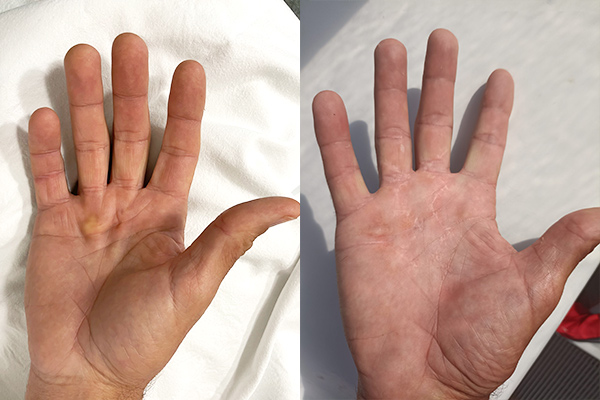Dupuytren’s Disease

Dupuytren’s Disease, also known as Dupuytren’s Contracture, affects the fascia in your hand, which lies beneath the skin and fat. It usually begins with nodules or lumps forming in your palm.
Dupuytren’s Disease
Over time, bands of fascia can develop into thick cords that contract, pulling one or more of your fingers into a bent position. From a functional perspective, it becomes difficult to put on a glove, to shake hands or to put your hand into your pocket.
Surgery for Dupuytren’s Disease involves removing the diseased fascia through a zig-zag scar that extends from the palm into the affected finger(s).



FAQs
The rate at which the disease progresses is unpredictable. In some patients it may never progress beyond the nodule stage. In other patients it develops early, progresses rapidly and can affect multiple fingers. Once the disease progresses to the stage that the fingers cannot be straightened, it adversely affects the functionality of the hand and surgery should be considered.
The most common surgical procedure performed to correct Dupuytren’s contracture is called a fasciectomy. This necessitates a general anaesthetic, but is usually done as a day case procedure. In some patients, if the disease has extensively infiltrated the overlying skin, a skin graft is required. Contractures limited to the knuckle can often be fully corrected with surgery. If the disease has resulted in a contracture in the joint beyond the knuckle, this can be improved with surgery but it may not be possible to fully straighten your finger, especially if you have had the disease for a long time.
Following your surgery, your hand is rested in splint for two weeks and you will not be able to drive for this period. Thereafter, it is recommended that you wear a splint at night for three months. It is not uncommon to experience swelling and stiffness after the surgery. Dr Collins will refer you to a hand therapist to ensure you get the best possible functional outcome. This may take six to eight weeks.
Your return to work will be determined by the type of job that you do. Patients in a supervisory or managerial role can often return to work after 2 weeks. If your work is more physically demanding, you may require 6 or more weeks of leave.
Each procedure is individually customised, considering your specific needs and aesthetic goals. As a result, the cost can vary from patient to patient. For more information on pricing or to begin your journey with Dr Collins please contact us.
There are two procedures that can be performed under local anaesthetic; needle fasciotomy and collagenase injections.
A needle fasciotomy involves dividing the Dupuytren’s cord(s) in your palm. This allows the finger to be straightened to a certain degree. As it is associated with high rates of recurrence, it is generally reserved for patients who don’t want to have surgery under general anaesthesia.
Collagenase is an enzyme that is injected into a Dupuytren’s cord to dissolve a portion of it. One to two days later, a second procedure is performed under local anaesthetic. The enzyme allows the cord to be broken and the finger to be straightened. This treatment is best suited to patients with contractures limited to the knuckle. It offers the advantage of avoiding surgery and a general anaesthetic, but is not suitable for all patterns of Dupuytren’s disease and more than one injection may be required.

